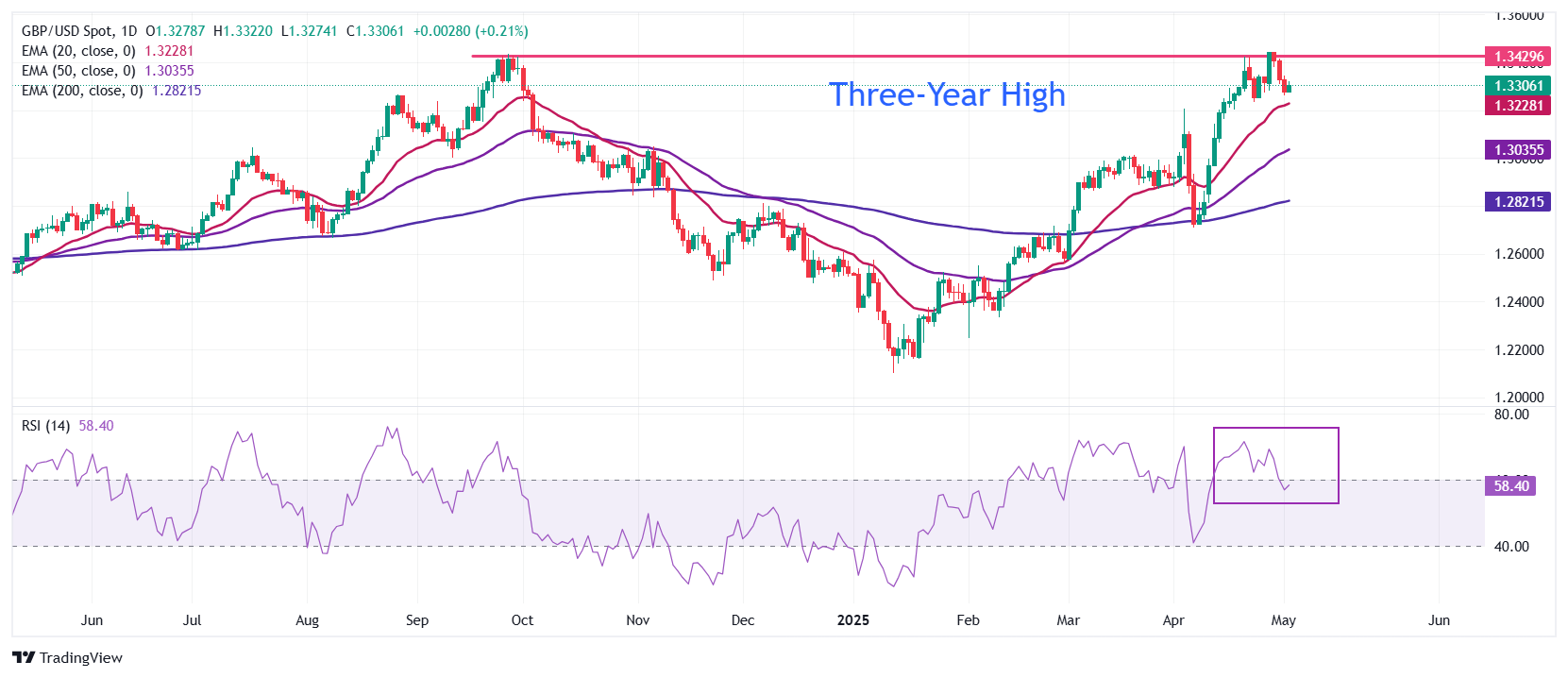- The Pound Sterling recovers against the US Dollar as investors’ risk appetite improves on hopes of de-escalation in the trade war between the US and China.
- The Fed is expected to keep interest rates steady, while the BoE is almost certain to cut them next week.
- Investors await the US NFP data for April, which will influence the Fed’s monetary policy outlook.
The Pound Sterling (GBP) bounces back to near 1.3320 against the US Dollar (USD) on Friday after a three-day correction. The GBP/USD pair gains as the market sentiment has turned cheerful after comments from the Chinese Commerce Ministry increased hopes of a de-escalation in the trade war between the United States (USD) and China.
On Thursday, the Chinese ministry signaled that the country is ready to discuss trade terms with Washington but emphasized that talks should be based on “sincerity”. “China says the door is open to trade talks with the US and urged the US to demonstrate sincerity if it wants trade talks,” Bloomberg reported.
Investors have taken these comments from Beijing as a constructive step towards resolving trade disputes between the world’s two largest nations. The optimism on Sino-US trade resolution has resulted in an increase in demand for risk-perceived currencies.
Market participants believe that Beijing won’t need to sell its products into other markets if the US continues to buy them. Investors were worried about fears that China would dump its products into European and Asian economies if its tariff war with the US continues. Given China’s low-cost competitive advantage, the competitiveness of products from other nations would have diminished in the global market. Such a scenario would have been unfavorable for their economic growth.
Though investors have underpinned the Pound Sterling against the US Dollar, it is underperforming among more risky peers on firm expectations that the Bank of England (BoE) will reduce interest rates by 25 basis points (bps) to 4.25% in its policy meeting on Thursday.
The reasons behind firm BoE dovish bets are global economic uncertainty in the face of tariffs announced by US President Donald Trump, a weak labor market outlook due to the increase in employers’ contribution to social security schemes, and softer-than-expected United Kingdom (UK) inflation data for March.
Daily digest market movers: Pound Sterling gains against USD ahead of US NFP data
- The Pound Sterling trades higher against the US Dollar in Friday’s European session. The pair rises as the US Dollar retraces ahead of the United States (US) Nonfarm Payrolls (NFP) data for April, which will be published at 12:30 GMT. The US Dollar Index (DXY), which tracks the Greenback’s value against six major currencies, corrects to near 99.85 from an over two-week high of 100.38.
- Investors will pay close attention to the US official employment data as it will indicate to what extent the tariff policy by President Donald Trump has impacted the job growth. The labor market data will also influence market expectations for the Federal Reserve’s (Fed) monetary policy outlook.
- The US economy is expected to have added 130K fresh workers, significantly lower than the March reading of 228K. The Unemployment Rate is estimated to have remained steady at 4.2%. Meanwhile, Average Hourly Earnings, a key measure of wage growth, is expected to have grown at a faster pace of 3.9% on year compared to the prior release of 3.8%. On a monthly basis, the wage growth measure is expected to have grown at a steady pace of 0.3%.
- Until the US labor market shows steady hiring, the Fed is unlikely to make monetary policy adjustments and will mainly focus on curbing elevated consumer inflation expectations. The ISM Manufacturing Prices Paid index showed on Thursday that input costs continued to grow at a faster pace. Business owners will eventually pass on higher costs to consumers, which will feed into inflation and limit the scope of monetary policy easing by the Fed. On the contrary, signs of slowing job growth would force the Fed to prioritize employment over inflation.
- After NFP, the next trigger for the US Dollar will be the Fed’s monetary policy decision, which will be announced on May 7. According to the CME FedWatch tool, traders are almost fully pricing in that the central bank will keep interest rates unchanged in the range of 4.25%-4.50%.
Technical Analysis: Pound Sterling recovers from 1.3260

The Pound Sterling recovers from the weekly low of 1.3260 against the US Dollar on Friday. The pair corrected in the last three trading days from the three-year high of 1.3445. The overall outlook of the pair remains bullish as all short-to-long Exponential Moving Averages (EMAs) are sloping higher.
The 14-day Relative Strength Index (RSI) strives to return above 60.00. A fresh bullish momentum would trigger if the RSI manages to do so.
On the upside, the three-year high of 1.3445 will be a key hurdle for the pair. Looking down, the April 3 high around 1.3200 will act as a major support area.
Pound Sterling FAQs
The Pound Sterling (GBP) is the oldest currency in the world (886 AD) and the official currency of the United Kingdom. It is the fourth most traded unit for foreign exchange (FX) in the world, accounting for 12% of all transactions, averaging $630 billion a day, according to 2022 data.
Its key trading pairs are GBP/USD, also known as ‘Cable’, which accounts for 11% of FX, GBP/JPY, or the ‘Dragon’ as it is known by traders (3%), and EUR/GBP (2%). The Pound Sterling is issued by the Bank of England (BoE).
The single most important factor influencing the value of the Pound Sterling is monetary policy decided by the Bank of England. The BoE bases its decisions on whether it has achieved its primary goal of “price stability” – a steady inflation rate of around 2%. Its primary tool for achieving this is the adjustment of interest rates.
When inflation is too high, the BoE will try to rein it in by raising interest rates, making it more expensive for people and businesses to access credit. This is generally positive for GBP, as higher interest rates make the UK a more attractive place for global investors to park their money.
When inflation falls too low it is a sign economic growth is slowing. In this scenario, the BoE will consider lowering interest rates to cheapen credit so businesses will borrow more to invest in growth-generating projects.
Data releases gauge the health of the economy and can impact the value of the Pound Sterling. Indicators such as GDP, Manufacturing and Services PMIs, and employment can all influence the direction of the GBP.
A strong economy is good for Sterling. Not only does it attract more foreign investment but it may encourage the BoE to put up interest rates, which will directly strengthen GBP. Otherwise, if economic data is weak, the Pound Sterling is likely to fall.
Another significant data release for the Pound Sterling is the Trade Balance. This indicator measures the difference between what a country earns from its exports and what it spends on imports over a given period.
If a country produces highly sought-after exports, its currency will benefit purely from the extra demand created from foreign buyers seeking to purchase these goods. Therefore, a positive net Trade Balance strengthens a currency and vice versa for a negative balance.

